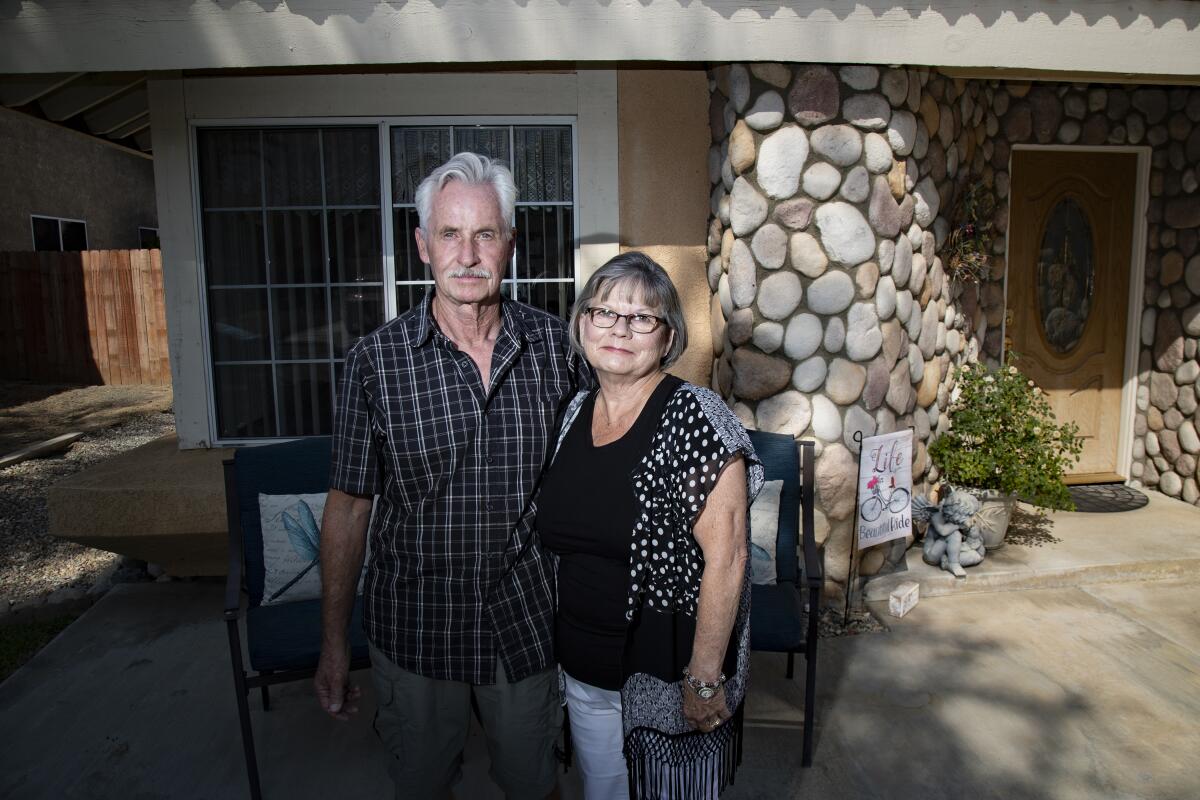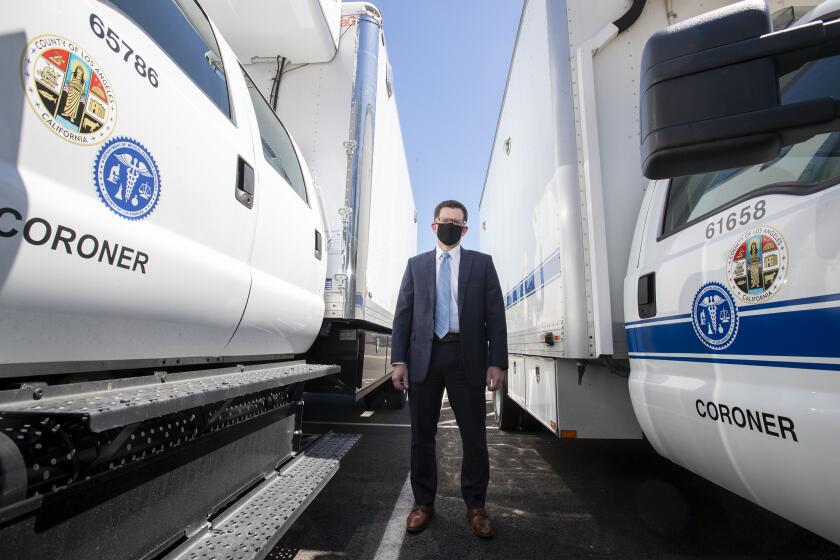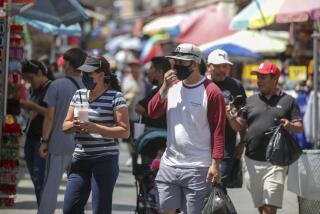Mysterious deaths of infants and others raise questions about how early coronavirus hit California

- Share via
A cluster of mysterious deaths, some involving infants and children, is under scrutiny amid questions of whether the novel coronavirus lurked in California months before it was first detected. But eight weeks after Gov. Gavin Newsom declared a statewide hunt for undetected early COVID-19 deaths, the effort remains hobbled by bureaucracy and testing limits.
Among those awaiting answers is Maribeth Cortez, whose adult son, Jeremiah DeLap, died Jan. 7 in Orange County while visiting his parents. He had been healthy, suffering on a Friday from what he thought was food poisoning, and found dead in bed the following Tuesday, drowned by fluid in his lungs.
For the record:
1:29 p.m. June 22, 2020This article incorrectly refers to streptococcal pneumonia as a virus. It is caused by a bacterial pathogen.
10:10 a.m. June 21, 2020In an earlier version of this article, Maribeth Cortez was erroneously referred to as Maribeth Ortiz.
China didn’t announce its first COVID-19 death until four days later. But by DeLap’s Feb. 1 funeral service, frightening stories of a deadly new virus in Wuhan dominated the news.
“Everybody that knew him when they were talking to me after this all started would say, ‘Do you think he died from that?’” Cortez said.
“And I said, ‘I don’t know.’”
She still doesn’t.
Preserved samples of DeLap’s lungs are among tissue from more than 40 California deaths waiting for a decision by the U.S. Centers for Disease Control and Prevention on whether to test for COVID-19. Orange County has nine of the cases, as does Los Angeles County. Kern County has identified two respiratory deaths that might suggest COVID-19, both of young women, one of whom died Dec. 21.
Interviews and internal documents show medical examiners in Shasta, Sacramento and Santa Clara counties, meanwhile, are scrutinizing the deaths of children and babies, amid growing recognition of COVID-19 infection rates in children who show mysterious inflammatory symptoms.
A positive finding in any of the cases could dramatically rewrite the narrative of COVID-19 in the United States.
Researchers tracking the virus’ genetic mutations peg its jump from an unknown animal host to humans as occurring in November. China’s first documented illnesses began in early December.
It was well into March before most California coroners and medical examiners began to routinely test decedents who fell under their jurisdiction for COVID-19, using now-familiar nasal swab tests that must be done within days of death. Even then, testing is limited to a fraction of cases — those who had symptoms of respiratory failure, traveled to China or died without witness.
Checking for missed cases of COVID-19 requires examining preserved tissue, a test available only through the CDC. It took months for CDC pathologists to realize the virus had already killed people in the United States in early February. At the time, U.S. health officials believed they could control the spread of the virus by monitoring international travelers and isolating a dozen known infected individuals in California and four other states.
New information emerging in the past week in California paints a very different picture of the spread of novel coronavirus than the one suggested by the first, official version.
DeLap, 39, worked as a house painter in Basalt, Colo., near the Aspen ski area. He returned to his inland Riverside County hometown for Christmas, and was at the home of his roommate’s parents in nearby Orange County on Jan. 3 when he became sick. He thought the cause was something he ate the night before. DeLap believed he was on the mend, even going for a walk Monday, but was worsening again Tuesday morning when he spoke to his mother.
“He was having trouble breathing and I told him he should try and go to the urgent care,” Cortez said. “He told me he’d talk to me later and he went and [lay] down.”
He was found dead in bed hours later, his lungs filled with fluid and his body still burning from fever.
The Orange County coroner ruled DeLap’s death the result of severe acute lobar pneumonia, one lung so congested it had doubled in weight. But the coroner did not identify the organism infecting DeLap. The thought that it might have been the coronavirus haunted Cortez as she heard story after story of similar deaths. DeLap was an organ donor, so four weeks ago Cortez called the organization that received his tissue to ask if they were going to test it for COVID-19.
Unknown to Cortez, the Orange County coroner harbored similar questions. DeLap’s death is among nine cases from late December to March that the county has asked the California Department of Public Health to consider. The deceased range in age from 33 to 61 and include an elderly homeless man found in his RV and a young surfer who collapsed. Initial autopsies attributed their deaths to congested lungs, pneumonia or blood clots.
If the state agency agrees, the cases will be forwarded to the CDC for more review before preserved tissue is tested for COVID-19. Los Angeles County’s medical examiner has forwarded nine cases for review, but county lawyers blocked the release of details. Tissue from a 10th Los Angeles death, a 17-year-old boy who died March 18, was sent two months ago to the CDC for COVID-19 testing. It came back last week positive for two other viruses: streptococcal pneumonia and human metapneumovirus.
After the CDC confirmed a Silicon Valley tech worker’s Feb. 6 death as the nation’s first known COVID-19 fatality, Newsom called on medical examiners statewide to hunt for missed cases extending back to mid-December.
But the CDC is limiting California — a state of 39 million people — to just eight to 10 cases a week. The state Health Department has stepped in as a gatekeeper between county morgues and the federal lab.
By the end of May, the state agency had forwarded only two cases to the CDC and had 40 other deaths under state review.
Such restrictions did not exist before the COVID-19 pandemic. They are new to Dr. Deirdre Amaro, the Shasta County sheriff’s forensic pathologist who relies on the CDC lab for infectious disease workups when someone dies inexplicably in her rugged, deeply forested Northern California county.
Amaro was jolted this winter by the back-to-back deaths of two children, one an infant, and local accounts of other sick children. She called a Jan. 29 meeting with county health and hospital officials. She remembered someone in the room theorizing that it was a “bad year” for respiratory syncytial virus, usually referred to as RSV. It is a common childhood disease that seldom kills.
“Since I’ve been here ... we have never had sequential cases that are pediatric deaths. I do NOT want to practice forensic pathology in a setting where that is the norm,” Amaro said. “The emotional/psychological toll is too great.”
She had already sent tissue from one of those pediatric deaths to the CDC for testing when the California Health Department set up hurdles. She has since sought virus testing for another pediatric death and is awaiting a decision on whether the CDC will accept the cases.
Early reports out of China and California suggested COVID-19 had very low infection rates among children.
“What has emerged now, the experience we’ve had on the East Coast and in Europe has been markedly different,” said Dr. Roberta Lynn DeBiasi, chief of the pediatric division at Children’s National Hospital in Washington, D.C., and a co-author of several studies on COVID-19 and children.
DeBiasi is among researchers who in May began documenting growing numbers of hospitalized children with COVID-19 and symptoms normally associated with an otherwise rare inflammatory illness called Kawasaki disease. Some had high fever, joint pain and rashes. Others had abdominal pain. An alarming number showed organ failure and heart damage, DeBiasi said.
Amid those reports, a California Health Department physician phoned Amaro, who in addition to her own two deaths told her of others — two infants sent from Shasta County to hospitals in Sacramento.
Dr. Chante Buntin, the state Health Department medical consultant, wrote to Sacramento County’s coroner expressing interest in infants and children who died with what might have been “COVID-like symptoms, Kawasaki-like symptoms in California during the period of December to present.”
Sacramento County’s coroner has sent a single case to the CDC for testing but has not provided further details.
California has no confirmed child deaths from COVID-19. The CDC in early April listed three suspected virus-related deaths of children nationwide, but has since not updated that information. The federal health agency has, however, alerted pediatricians to watch for signs of what it now calls “multisystem inflammatory syndrome in children,” or MIS-C.
The California Department of Public Health did not answer questions about its hunt for child deaths, and gave only limited responses to broader questions about postmortem testing. The agency did provide an email exchange in which a state epidemiologist offered to intervene on a “flood of requests” from California medical examiners, health departments and pathologists seeking COVID-19 testing for both deceased adults and children.
The pandemic’s toll: Lives lost in California
Hundreds of people have died in California due to the COVID-19 pandemic. These are some of their stories.
Dr. Shua Chai told the CDC that California would narrow its criteria for testing the dead, based not on the questions arising in morgues but to fit the number of cases the CDC lab would take.
“The capacity will really help drive our prioritization,” Chai said.
At first the federal agency said it could handle only three to four cases a week and that it could take as long as two months to send back results. On May 1, the head of the CDC’s COVID-19 mortality team suggested the federal lab would take as many as 10 a week.
“I’m not saying this will be acceptable by my leadership,” warned Dr. Sarah Reagan-Steiner, clinical lead on the CDC’s COVID-19 mortality unit. There was no response to repeated questions sent to the CDC public affairs office over several months regarding postmortem testing.
The state Health Department’s press office defended the state’s reliance on the CDC and the federal agency’s 10-case weekly limit. Medical examiners in other states are not only testing many more dead, but also using other methods such as postmortem testing for antibodies.
The state agency’s press office said the CDC testing was “highly specialized and requires careful validation.”
“Other types of testing may not provide results that are as reliable as CDC testing.”
In Seattle, the King County medical examiner considers death itself as a reason to test on the spot for the virus with a nasal swab.
“COVID-19 is so new as an infection, and it probably affects different people in different ways,” associate Medical Examiner Dr. Sharon Yarid said. “So anyone who dies basically had, you know, already some reason to be tested.”
King County is scanning funeral homes for cases to test and checking blood serum from older cases for signs of COVID-19 antibodies. Family members have only to ask to have a death tested for the virus.
The liberal guidelines have led to the identification of 58 additional COVID-19 deaths, including young adults, and accounting for more than one out of 10 local deaths attributed to the virus. That’s nearly double the 29 coronavirus deaths identified under the more restrictive policies of the Los Angeles County medical examiner, though Los Angeles County has more than five times the number of COVID-19 cases. (The medical examiner handles only violent, sudden or unusual deaths, which account for a relatively small percentage of overall COVID-19 deaths.)
Yet when it comes to testing preserved tissue, Yarid is also at the mercy of the CDC. She said she had asked the federal lab to evaluate a troubling Feb. 6 death. As of last week, Yarid said she had not received an answer.
Those frustrated by the hurdle in answering the question — was it COVID-19? — include family members of a man found dead on a Los Angeles bus bench in late January. The Los Angeles County medical examiner-coroner’s office classified the death as “complications of alcohol abuse,” though there was no sign of recent alcohol use.
The man’s brother, who asked not to be named in order to preserve family privacy, said the medical examiner had refused repeated requests to test the body for COVID-19.
“They have not, they haven’t really gotten off of that February, March, early April mindset that we live in an environment of testing scarcity,” said the brother.
Los Angeles County supervisors cited such complaints this month in telling the medical examiner’s office to provide COVID-19 testing for families who ask for it. A spokeswoman for the medical examiner said the office was still working out a procedure.
Not all California medical examiners are seeking CDC testing for missed COVID-19 deaths.
“So you found that there were several cases that were not identified early on ... what does that tell you?” Ventura County Medical Examiner Dr. Christopher Young said. “How does that add to where we’re at with dealing with the COVID-19 pandemic right now?”
San Diego officials told The Times that a paper review of more than 700 deaths had turned up none that met the state’s written criteria — deaths from Dec. 17 to March 16, with signs of respiratory failure, fever or cough, or known exposure to COVID-19 or international travel.
San Mateo County, a part of Silicon Valley home to California’s earliest COVID-19 cases, identified one suspect death.
According to agency emails, a county pathologist checked the freezer for tissue to send to the CDC, and discovered the samples had been “tossed,” along with tissue from everyone else who died prior to March 11.
More to Read
Sign up for Essential California
The most important California stories and recommendations in your inbox every morning.
You may occasionally receive promotional content from the Los Angeles Times.













